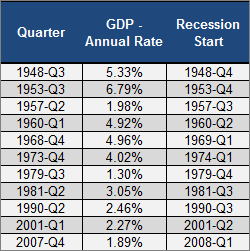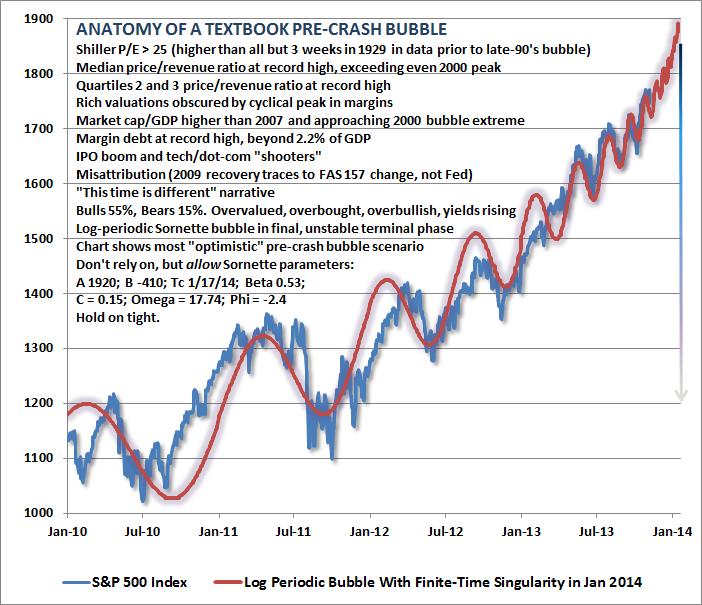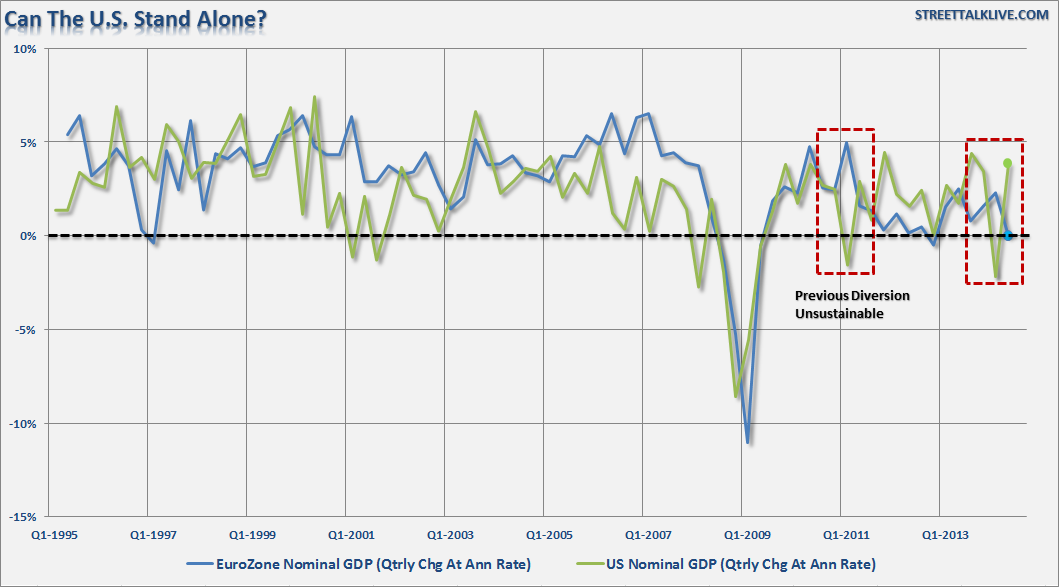The first half of this week has been very interesting from an economic, financial and geopolitical viewpoint. Despite what appears to be globally increasing risks, the financial markets have seemed relatively unfazed. Historically, such calm has always existed prior to the eventual storm. This week’s “3 Things” takes a look at some of the “rising risks” that I believe are being ignored that could potentially be harmful to individual's portfolios.
(Note: Identifying risks does not mean to “sell everything and run to cash.” As noted in this past weekend’s newsletter that discussed the markets recent “sell signal”:
'The current 'sell' signal does not mean 'panic sell' everything you own in your portfolio and run to cash. Initial sell signals can be short lived particularly when the Federal Reserve is still intervening in the markets.
Furthermore, by the time a WEEKLY sell signal is issued the markets are already OVERSOLD on a short term basis. It is very likely, that a rally will ensue in the markets over the next week back to resistance that could be used to rebalance portfolios and reduce the risk more prudently.”
By being aware of “risks,” we can make better portfolio allocation decisions in order to preserve capital and produce better-long term returns.
Oxymoron
There is an interesting phenomenon occurring in the financial markets that absolutely, positively, will not last indefinitely – the “Giant Shrinking Correction.” The chart below shows the S&P 500 (weekly closing data) since the beginning of 2009, with all relevant corrections identified in terms of percentage.
There are two important points to note. First, each correction since the end of QE2 has been increasingly smaller. This is very much in line with a prediction made in November, 2013 by John Hussman when he stated:
“A discussion of bubble risk would be incomplete without defining the term itself. From an economist’s point of view, a bubble is defined in terms of differential equations and a violation of ‘transversality.’ In simpler language, a bubble is a speculative advance where prices rise on the expectation of future advances and become largely detached from properly discounted fundamentals. A bubble reflects a widening gap between the increasingly extrapolative expectations of market participants and the prospective returns that can be estimated through present-value relationships linking prices and likely cash flows.
As economist Didier Sornette observed in Why Markets Crash, numerous bubbles in securities and other asset markets can be shown to follow a ‘log periodic’ pattern where the general advance becomes increasingly steep, while corrections become both increasingly frequent and gradually shallower. I’ve described this dynamic in terms of investor behavior that reflects increasingly immediate impulses to buy the dip.”
Secondly, I have noted in the chart above (red vertical dashed line) the onset of the most recent QE program. As noted, corrections since December of 2012 have never taken the markets back to extremely oversold levels as had occurred previously. With the Federal Reserve now reducing monetary interventions, it is likely that volatility will increase and corrections will once again become deeper.
The issue, as discussed by Hussman, is the current “risk on” environment will most assuredly swing to “risk off.” It is at this point that most investors are paralyzed into inaction as the realization of what was said “could not happen,” does.
Stanley Fischer And The Structural Shift
This past Monday, Stanley Fischer, the official who took over as Vice Chairman of the Federal Reserve in June, commented that the weak economic recovery might simply be continued fallout from the financial crisis and subsequent recession. However, “it is also possible that the underperformance reflects a more structural, longer-term shift in the global economy.”
I spilled some digital ink on his comments yesterday discussing the impact of debt and consumption on the “structural shift” in economic growth. However, my good friend Doug Short really hit home with his destruction of the “labor force is a function of retiree’s” meme.
“[The following chart]…essentially demolishes Fischer's view of our aging population as a demographic drag on labor supply. Here is the ratio of the 65-and-over cohort as a percent of the employed civilian population all the way back to 1948, the earliest year of BLS employment data. Mind you ... these people are not only in the workforce, but also actually employed.”
“The percentage of elderly employment is at its historic high -- now double its low in the mid-1980s. This is a trend with multiple root causes, most notably longer lifespans, the decline in private sector pensions and frequent cases of insufficient financial planning.
I would dismiss Vice Chairman Fischer's reference to ‘considerable uncertainty’ in the interpretation of labor supply weakness as routine Fedspeak. We are most certainly experiencing a structural change in employment, one that is a major drag on the overall economy. The fact this change was (not surprisingly) exacerbated by a business cycle downturn should not blind us to its structural nature. While this change will not be permanent, it will be a burden on economic growth for many years to come.”
Can The U.S. Economy Really Stand Alone
The following chart is food for thought. There are extremely high expectations that the U.S. economy will achieve “lift off” in terms of economic growth eventually achieving 3-4% annualized growth rates. The chart below shows the nominal GDP of the Eurozone and U.S.
Is it possible, that in globally interconnected economy, the U.S. can stand alone?
While there are many prognostications that a recession is “nowhere in sight,” it is important to remember that recessions are a function of REVISED economic data. In other words, the reason that the National Bureau of Economic Research has never predicted a recession is because they must wait for the revisions to past data to determine the start and end dates of recessions.
However, it is also important to remember that as shown in the table below, it is often quite common to see strong economic data just before the onset of a recession.

While the Q2-2014 GDP print of 3.9% was certainly welcome following a dismal Q1, with Japan and the Eurozone economies slowing markedly, the spillover into the U.S. will likely be seen in Q3. As noted in the NYT, by David Jolly,
“Economic growth in the Eurozone sputtered to a halt in the second quarter as Germany contracted, and France stagnated again.
The gross domestic product of the 18 nations that share the euro did not expand at all from the first quarter of this year, when it grew 0.2 percent, according to Eurostat, the European Union’s statistics agency in Luxembourg.
The performance in the Eurozone bodes poorly for the already shaky global economic outlook. It comes a day after Japan reported that its G.D.P. shrank at an annual rate of 6.8 percent in the second quarter, and after the United States reported a rebound to 4 percent annualized growth following a dismal start to the year.”
As shown in the chart above, it is not uncommon to see a spurt of economic growth prior to the onset of a recession. Just as important is that recessions tend not to be a gradual thing, but rather a sharp plunge in activity caused by some exogenous event (oil prices, terrorism, war, etc.)
It will be worth watching the income data closely in the months ahead. Sluggish retail sales, very weak imports, and the drag on exports due to our trading partners' economic drags (which makes up about 40% of corporate profits) suggest that Q2 may be the best we see this year.





